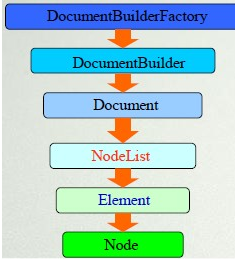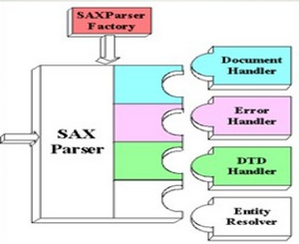XML和JSON是两种常用的数据交换格式。虽然对于XML和JSON的各种操作,仅仅是常用的工具jar包的使用,没有什么技术含量,但鉴于这两种数据格式的普遍使用,还是拿出一点时间,进行一下简单总结。
XML
XML官网:http://www.xml.com/
XML保留字符有5个:&、>、<、'、""。
对于XML的解析方式,有两种:DOM方式和SAX方式。DOM是读入内存之后进行各种操作,SAX是流式操作、一次性的。其他的一些工具jar包,比如JDOM、DOM4J,都是对于这两种方式的高层次封装。
参考网址:
http://inotgaoshou.iteye.com/blog/1012188
DOM图示:
SAX图示:
演示代码:
import java.io.File;
import java.util.Stack;
import javax.xml.parsers.DocumentBuilder;
import javax.xml.parsers.DocumentBuilderFactory;
import javax.xml.parsers.SAXParser;
import javax.xml.parsers.SAXParserFactory;
import org.w3c.dom.Attr;
import org.w3c.dom.Comment;
import org.w3c.dom.Document;
import org.w3c.dom.Element;
import org.w3c.dom.NamedNodeMap;
import org.w3c.dom.Node;
import org.w3c.dom.NodeList;
import org.xml.sax.Attributes;
import org.xml.sax.SAXException;
import org.xml.sax.helpers.DefaultHandler;
/**
* 演示两种XML的解析方式:DOM和SAX
*
* 至于JDOM和DOM4J,只是在这两种方式之上的更高层次的封装
*
*/
public class XmlDemo {
public static void main(String[] args) throws Exception {
XmlDemo xmlDemo = new XmlDemo();
// DOM方式
DomDemo domDemo = xmlDemo.new DomDemo("src/main/java/com/cl/roadshow/java/xml/people.xml");
domDemo.iterateByName("PERSON");
domDemo.recursiveElement();
// SAX方式
SaxDemo saxDemo = xmlDemo.new SaxDemo("src/main/java/com/cl/roadshow/java/xml/people.xml");
saxDemo.showEvents();
saxDemo.parseDocument();
}
/**
* DOM方式解析XML
*
*/
class DomDemo {
private String path;
public DomDemo(String path) {
this.path = path;
}
/**
* 查询所有符合给到名称的Node,大小写敏感
*
* @param tagName
* @throws Exception
*/
public void iterateByName(String tagName) throws Exception {
// 获得DOM解析器工厂
DocumentBuilderFactory dbf = DocumentBuilderFactory.newInstance();
// 获得具体的DOM解析器
DocumentBuilder db = dbf.newDocumentBuilder();
// 解析XML文档,获得Document对象(根结点)
Document doc = db.parse(new File(path));
NodeList nodeList = doc.getElementsByTagName(tagName);
for (int i = 0; i < nodeList.getLength(); i++) {
Element element = (Element) nodeList.item(i);
String content = element.getElementsByTagName("NAME").item(0).getFirstChild().getNodeValue();
System.out.println("name:" + content);
content = element.getElementsByTagName("ADDRESS").item(0).getFirstChild().getNodeValue();
System.out.println("address:" + content);
content = element.getElementsByTagName("TEL").item(0).getFirstChild().getNodeValue();
System.out.println("tel:" + content);
content = element.getElementsByTagName("FAX").item(0).getFirstChild().getNodeValue();
System.out.println("fax:" + content);
content = element.getElementsByTagName("EMAIL").item(0).getFirstChild().getNodeValue();
System.out.println("email:" + content);
System.out.println("--------------------------------------");
}
}
/**
* 从根节点开始,遍历XML的所有元素
*
* @throws Exception
*/
public void recursiveElement() throws Exception {
DocumentBuilderFactory dbf = DocumentBuilderFactory.newInstance();
DocumentBuilder db = dbf.newDocumentBuilder();
Document doc = db.parse(new File(path));
// 获得根元素结点
Element root = doc.getDocumentElement();
parseElement(root);
}
/**
* 递归方法
*
* @param element
*/
private void parseElement(Element element) {
String tagName = element.getNodeName();
NodeList children = element.getChildNodes();
System.out.print("<" + tagName);
// element元素的所有属性所构成的NamedNodeMap对象,需要对其进行判断
NamedNodeMap map = element.getAttributes();
// 如果该元素存在属性
if (null != map) {
for (int i = 0; i < map.getLength(); i++) {
// 获得该元素的每一个属性
Attr attr = (Attr) map.item(i);
String attrName = attr.getName();
String attrValue = attr.getValue();
System.out.print(" " + attrName + "=\"" + attrValue + "\"");
}
}
System.out.print(">");
for (int i = 0; i < children.getLength(); i++) {
Node node = children.item(i);
// 获得结点的类型
short nodeType = node.getNodeType();
if (nodeType == Node.ELEMENT_NODE) {
// 是元素,继续递归
parseElement((Element) node);
} else if (nodeType == Node.TEXT_NODE) {
// 递归出口
System.out.print(node.getNodeValue());
} else if (nodeType == Node.COMMENT_NODE) {
System.out.print("<!--");
Comment comment = (Comment) node;
// 注释内容
String data = comment.getData();
System.out.print(data);
System.out.print("-->");
}
}
System.out.print("</" + tagName + ">");
}
}
/**
* SAX方式解析XML
*
*/
class SaxDemo {
private String path;
public SaxDemo(String path) {
this.path = path;
}
public void showEvents() throws Exception {
// 获得SAX解析器工厂实例
SAXParserFactory factory = SAXParserFactory.newInstance();
// 获得SAX解析器实例
SAXParser parser = factory.newSAXParser();
// 开始进行解析
parser.parse(new File(path), new EventHandler());
}
public void parseDocument() throws Exception {
// 获得SAX解析器工厂实例
SAXParserFactory factory = SAXParserFactory.newInstance();
// 获得SAX解析器实例
SAXParser parser = factory.newSAXParser();
// 开始进行解析
parser.parse(new File(path), new ParseHandler());
}
/**
* 演示SAX解析方式的事件驱动过程
*
*/
class EventHandler extends DefaultHandler {
@Override
public void startDocument() throws SAXException {
System.out.println("\n--------------------------------------");
System.out.println("start document");
}
@Override
public void endDocument() throws SAXException {
System.out.println("finish document");
System.out.println("--------------------------------------");
}
@Override
public void startElement(String uri, String localName, String qName, Attributes attributes) throws SAXException {
System.out.println("start element");
}
@Override
public void endElement(String uri, String localName, String qName) throws SAXException {
System.out.println("finish element");
}
}
/**
* 演示用SAX方式解析PERSON节点的过程
*
*/
class ParseHandler extends DefaultHandler {
private Stack<String> stack = new Stack<String>();
private String name;
private String tel;
@Override
public void startElement(String uri, String localName, String qName, Attributes attributes) throws SAXException {
stack.push(qName);
for (int i = 0; i < attributes.getLength(); i++) {
String attrName = attributes.getQName(i);
String attrValue = attributes.getValue(i);
System.out.println(attrName + "=" + attrValue);
}
}
@Override
public void characters(char[] ch, int start, int length) throws SAXException {
String tag = stack.peek();
if ("NAME".equals(tag)) {
name = new String(ch, start, length);
} else if ("TEL".equals(tag)) {
tel = new String(ch, start, length);
}
}
@Override
public void endElement(String uri, String localName, String qName) throws SAXException {
stack.pop(); // 表示该元素已经解析完毕,需要从栈中弹出
if ("PERSON".equals(qName)) {
System.out.println("NAME:" + name);
System.out.println("TEL:" + tel);
System.out.println();
}
}
}
}
}
JSON
JSON官网:http://www.json.org/json-zh.html
对于JSON的解析,各种语言下都有 很多可用客户端,在Java下,fastjson是推荐使用的一种,快、强大、无依赖。
代码演示:
import java.util.ArrayList;
import java.util.HashMap;
import java.util.List;
import java.util.Map;
import com.alibaba.fastjson.JSON;
import com.alibaba.fastjson.TypeReference;
/**
* fastjson 是一个性能很好的 Java 语言实现的 JSON 解析器和生成器,来自阿里巴巴的工程师开发
*
*
* 主要特点:比其它任何基于Java的解析器和生成器更快,包括jackson;强大;零依赖
*
*/
public class FastjsonDemo {
public static void main(String[] args) {
// 将JSON和JavaBean对象互相转换
Person person = new Person(1, "张三", null);
String jsonString = JSON.toJSONString(person);
System.out.println(jsonString);
person = JSON.parseObject(jsonString, Person.class);
System.out.println(person.getName());
System.out.println("--------------------------------------");
// 将JSON字符串转化成List<JavaBean>对象
Person person1 = new Person(1, "fastjson1", 11);
Person person2 = new Person(2, "fastjson2", 22);
List<Person> persons = new ArrayList<Person>();
persons.add(person1);
persons.add(person2);
jsonString = JSON.toJSONString(persons);
System.out.println("json字符串:" + jsonString);
persons = JSON.parseArray(jsonString, Person.class);
System.out.println(persons.toString());
System.out.println("--------------------------------------");
// 将JSON字符串转化成List<String>对象
List<String> list1 = new ArrayList<String>();
list1.add("fastjson1");
list1.add("fastjson2");
list1.add("fastjson3");
jsonString = JSON.toJSONString(list1);
System.out.println(jsonString);
List<String> list2 = JSON.parseObject(jsonString, new TypeReference<List<String>>() {
});
System.out.println("list2:" + list2.toString());
System.out.println("--------------------------------------");
// JSON<Map<String,Object>>对象
Map<String, Object> map = new HashMap<String, Object>();
map.put("key1", "value1");
map.put("key2", "value2");
Map<String, Object> map2 = new HashMap<String, Object>();
map2.put("key1", 1);
map2.put("key2", 2);
List<Map<String, Object>> list3 = new ArrayList<Map<String, Object>>();
list3.add(map);
list3.add(map2);
jsonString = JSON.toJSONString(list3);
System.out.println("json字符串:" + jsonString);
List<Map<String, Object>> list4 = JSON.parseObject(jsonString, new TypeReference<List<Map<String, Object>>>() {
});
System.out.println("list4:" + list4.toString());
}
}
class Person {
private Integer id;
private String name;
private Integer age;
public Person() {
}
public Person(Integer id, String name, Integer age) {
super();
this.id = id;
this.name = name;
this.age = age;
}
public Integer getId() {
return id;
}
public void setId(Integer id) {
this.id = id;
}
public String getName() {
return name;
}
public void setName(String name) {
this.name = name;
}
public Integer getAge() {
return age;
}
public void setAge(Integer age) {
this.age = age;
}
@Override
public String toString() {
StringBuilder sb = new StringBuilder();
sb.append("ID:").append(id);
sb.append("-Name:").append(name);
sb.append("-Age:").append(age);
return sb.toString();
}
}


























 2869
2869

 被折叠的 条评论
为什么被折叠?
被折叠的 条评论
为什么被折叠?








